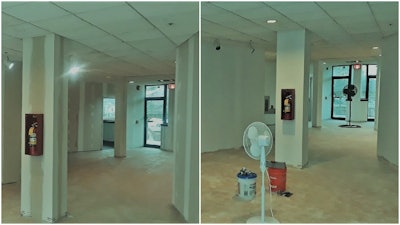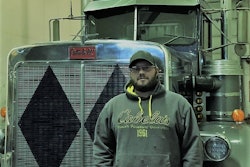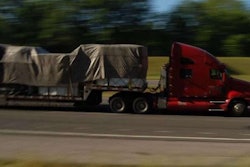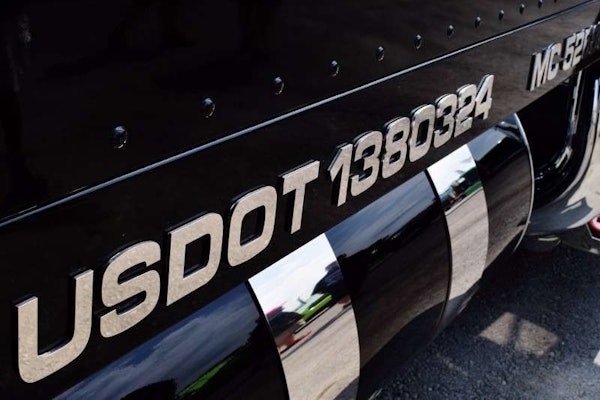Texas-based owner-operator Rob Goodwin met Riteload founder Matthew Kane in 2012 at a truck stop in Spokane, Wash., during Kane’s early runs around the nation in attempts to talk up what was then, and remains today, a fairly novel idea — a tech platform that connects shippers, not brokers, directly to carriers who want to move their loads. As Kane’s platform has gotten off the ground and (after a Riteload reboot or two I’ve written about before) started to really offer some utility to owner-operators and other carriers, owner-operator Goodwin is about to haul his fourth load of this year booked with a shipper in the system, hauling out of Yorktown, Indiana, to a Florida destination.
“Last year,” he says, “I moved 15 or 20 or so loads booked there,” each costing him a transparent, single fee of $27 dollars, a fee that’s universal for truckers on the platform. (It’s free to sign up.)
 Owner-operator Rob Goodwin and his American bulldog and on-truck best friend, Patty.
Owner-operator Rob Goodwin and his American bulldog and on-truck best friend, Patty.One particular run that worked well with his reefer last year was farm-to-farm direct on the lane between Maine and Florida, hauling potato seeds southbound and potatoes back north — “I did that all winter long, and every bit of it was through Riteload.”
It wasn’t this pathetic $1.12-a-mile stuff you might see offered to load a reefer coming out of Florida with a broker, either; it was well above $2 both ways, the southbound haul the slightly higher of the two most times, naturally. “I’m probably 60% brokered freight today” otherwise, says Goodwin, dispatching himself leased under the authority of Joey Terra’s Terra Trucking after Goodwin closed his own authority some years back. The other 40% of his freight is either through a direct account or booked through shippers utilizing Riteload.
 Goodwin hauls in this 2000 Western Star, powered by a 60 series Detroit and shown here unloading potatoes.
Goodwin hauls in this 2000 Western Star, powered by a 60 series Detroit and shown here unloading potatoes.“I just love everything Riteload stands for,” Goodwin says. “It’s always good to be able to cut somebody’s hand out of your portion of the pie – that’s more money in the bank” for him.
That’s been Kane’s goal from the beginning, amid skepticism that he’d see any kind of success. Clearly, he’s doing something right. “We’re two and a half weeks away from moving furniture into” the 33,000-square-foot facility Riteload purchased just outside of Philadelphia as a new office, he says. “We’re remodeling about 11,000 square feet of space there after gutting it entirely.”
 Exterior view of the building in Southhampton, Penn., that Kane and company purchased, with plenty room to expand beyond the initial used 11,000 square feet.
Exterior view of the building in Southhampton, Penn., that Kane and company purchased, with plenty room to expand beyond the initial used 11,000 square feet.“It’s important that people understand that we’re here to stay,” Kane says, addressing some skepticism he continues to see from parts of the owner-operator community and from freight middlemen out there, including those who feel that what they’re doing actually constitutes brokering freight itself. Yet “we did get a letter from the FMCSA stating that we’re not a broker” after laying out the business model.
 A little recent before-and-after with paint and drywall work inside the new Riteload building.
A little recent before-and-after with paint and drywall work inside the new Riteload building.“We’ve got more shippers” ready to offer loads within the system “than we need at this point,” Kane says. “I need carriers. We’ve got shippers now that we’re holding at bay” until he feels enough carriers are on board to cover freight posted with the network. For numbers of owner-operators and drivers signed up with the company, “we’re hanging in the 55,000-56,000 range right now, but we need to get to 200,000,” he believes.
Goodwin’s learned a few tricks to effectively use the Riteload application, which works on smartphones and tablets — it’s all about setting your preferences so that you’re alerted to an available load that meets those preferences before it’s tendered to a trucker by a shipper and disappears. “The way it works now, it’s almost like vultures circling” whenever a load is posted, with a “latency period for someone else to see the load beyond the first few who get there.” He learned some time ago, though, that setting preferences will allow the system to alert you via email for loads with your trailer type and/or picking up in specific locations.
Also, “they’ve streamlined the app now for the payment process,” too, says Goodwin.
Kane says it’s a 3 percent quick-pay fee for payment with 48 hours of dropping the load. Adds Goodwin, “As long as you get good clear pictures of your BOL, the app will initiate a direct deposit. If there’s any kind of an issue, they’re real quick to call. He’s got great support people.”











